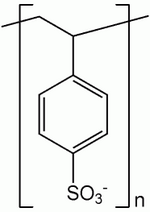The patient, a 63-year-old woman, had past medical history significant for diabetes mellitus, hypertension, congestive heart failure, and a pelvic mass. The serum electrolyte sample showed hyperkalemia (serum potassium 6.2 mEq/L, serum creatinine 4.1 mg/dL, blood urea nitrogen 87 mg/dL; the sample was not hemolyzed). She was taken to the emergency room. The hyperkalemia was treated with kayexalate (sodium polystyrene sulfonate) in the emergency room, and she was admitted to the hospital, where continued efforts were made to manage the hyperkalemia. However, she was found unresponsive the morning after admission, and efforts at resuscitation were unsuccessful. Postmortem examination revealed the pelvic mass to be a small cell neuroendocrine tumor, apparently arising from the cervix with extensive involvement of the uterine myometrium, extensive peritoneal implants, invasion into the wall of the bladder, compression of the ureters, and invasion of the inferior vena cava. There was no evidence of distant metastasis. She was also found to have massive cardiomegaly (dilated and hypertrophie) and nodular glomerulosclerosis. There was pulmonary congestion with edema. In addition, there were irregular, sharply angulated basophilic materials of varying sizes with little or no tissue reaction in the alveoli (Figure 1). These materials have parallel laminations (Figure 2). Degenerated bronchial cells are occasionally seen with the materials (Figure 2). These materials in the lungs are aspirated kayexalate (sodium polystyrene sulfonate). Kayexalate is a cation-exchange resin given enterally for the treatment of hyperkalemia.1 There is characteristic basophilic, amorphous foreign material in airspaces on histologie sections. The identity of this material can be confirmed by Fourier transform infrared microspectrophotometry,1 but this is often not necessary because of the characteristic appearance. The parallel laminations of the kayexalate are thought to be an artifact of sectioning.2 Aspirated vegetable matter and meat fibers may be considered in the differential diagnosis, but these do not have the parallel laminations of kayexalate. Kayexalate aspiration typically does not cause pneumonia, but there have been reports of cases of pneumonitis following its aspiration.3 The pneumonitis following kayexalate aspiration may in fact be due to accompanying aspirated acidic gastric content and not necessarily due to kayexalate.
References
1. Fenton JJ, Johnson FB, Przygodzk RM, et al. Sodium polystyrene sulfonate (kayexalate) aspiration: histologic appearance and infrared microspectrophotometric analysis of two cases. Arch Pathol Lab Med. 1996;120:967-969.
2. Travis WD, Colby TV, Koss MN, et al. Non-Neoplastic Disorders of the Lower Respiratory Tract. Washington, DC: Armed Forces Institute of Pathology; 2002. Atlas of Nontumor Pathology, fascicle 2.
3. Haupt HM, Hutchins CM. Sodium polystyrene sulfonate pneumonitis. Arch Intern Med. 1982; 142:379-381.
Michael O. Idowu, MD; Michelle Mudge, DO; Nitya R. Chatak, MD
Accepted for publication August 25, 2004.
From the Department of Pathology, Virginia Commonwealth University Health Systems, Medical College of Virginia Hospitals, Richmond.
The authors have no relevant financial interest in the products or companies described in this article.
Reprints: Nitya R. Ghatak, MD, Department of Pathology, VCUHS/ MCVH, 1101 E Marshall St, PO Box 980017, Richmond, VA 232980017 (e-mail: nrghatak@vcu.edu).
Copyright College of American Pathologists Jan 2005
Provided by ProQuest Information and Learning Company. All rights Reserved



